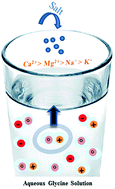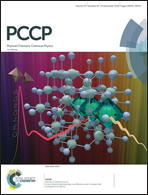Cation-specific interactions of protein surface charges in dilute aqueous salt solutions: a combined study using dielectric relaxation spectroscopy and Raman spectroscopy†
Abstract
We exploited glycine as a zwitterionic model system to experimentally probe the cation specific interaction of protein surface charges in dilute (≤0.25 mol L−1) aqueous solutions of four biologically relevant inorganic salts, NaCl, KCl, MgCl2 and CaCl2, via dielectric relaxation spectroscopy (DRS) and Raman spectroscopy. Glycine is the simplest building block of proteins and it exposes the same charged groups (carboxylate and ammonium) to the solvent that dominate the protein–water interface. As a counter ion, we selected Cl− due to its biological importance. For all systems, we performed simultaneous fitting of the real (ε′) and imaginary (ε″) parts of the dielectric functions, assuming a multimodal relaxation model, obtained from concentration dependent dielectric measurements at ∼293 K. We observe a reduction of the dielectric amplitude for the glycine relaxation while the corresponding time constant shows only small (<7%) deviations compared to aqueous glycine solutions. We propose that the observed reduction in dielectric amplitude is due to a reduction of the effective dipole moment (µeff) of zwitterionic glycine caused by the interaction of glycine with the ion even at very low (0.05 M) salt concentrations. The interaction between divalent metal ions and zwitterionic glycine is increased compared to the monovalent cation–zwitterion interaction; a finding that is also supported by Raman spectroscopy. Our combined dielectric relaxation and Raman spectroscopic study indicates that ion–glycine interactions are weak and mediated by the solvent. Cation-specificity of protein surface charges is also observed in dilute salt solutions (≤0.25 mol L−1), where electrostatic interactions dominate.



 Please wait while we load your content...
Please wait while we load your content...